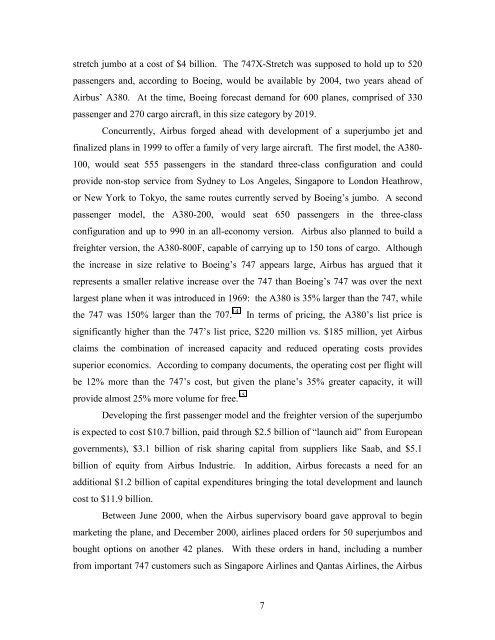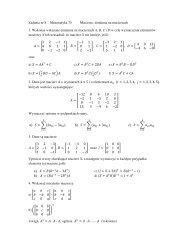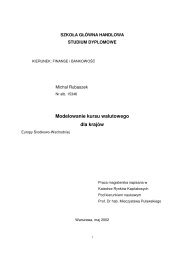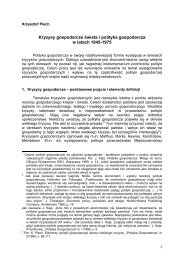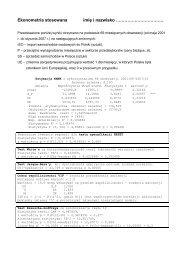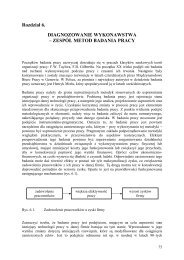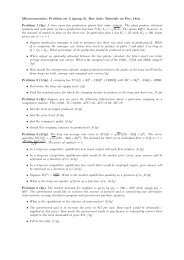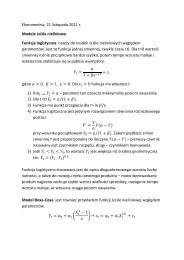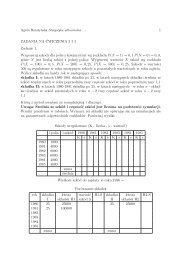stretch jumbo at a cost <strong>of</strong> $4 billion. The 747X-Stretch was supposed to hold up to 520passengers and, accord<strong>in</strong>g to <strong>Boe<strong>in</strong>g</strong>, would be available by 2004, two years ahead <strong>of</strong>Airbus’ A380. At the time, <strong>Boe<strong>in</strong>g</strong> forecast demand for 600 planes, comprised <strong>of</strong> 330passenger and 270 cargo aircraft, <strong>in</strong> this size category by 2019.Concurrently, Airbus forged ahead with development <strong>of</strong> a superjumbo jet andf<strong>in</strong>alized plans <strong>in</strong> 1999 to <strong>of</strong>fer a family <strong>of</strong> very large aircraft. The first model, the A380-100, would seat 555 passengers <strong>in</strong> the standard three-class configuration and couldprovide non-stop service from Sydney to Los Angeles, S<strong>in</strong>gapore to London Heathrow,or New York to Tokyo, the same routes currently served by <strong>Boe<strong>in</strong>g</strong>’s jumbo. A secondpassenger model, the A380-200, would seat 650 passengers <strong>in</strong> the three-classconfiguration and up to 990 <strong>in</strong> an all-economy version. Airbus also planned to build afreighter version, the A380-800F, capable <strong>of</strong> carry<strong>in</strong>g up to 150 tons <strong>of</strong> cargo. Althoughthe <strong>in</strong>crease <strong>in</strong> size relative to <strong>Boe<strong>in</strong>g</strong>’s 747 appears large, Airbus has argued that itrepresents a smaller relative <strong>in</strong>crease over the 747 than <strong>Boe<strong>in</strong>g</strong>’s 747 was over the nextlargest plane when it was <strong>in</strong>troduced <strong>in</strong> 1969: the A380 is 35% larger than the 747, whilethe 747 was 150% larger than the 707. 14 In terms <strong>of</strong> pric<strong>in</strong>g, the A380’s list price issignificantly higher than the 747’s list price, $220 million <strong>vs</strong>. $185 million, yet Airbusclaims the comb<strong>in</strong>ation <strong>of</strong> <strong>in</strong>creased capacity and reduced operat<strong>in</strong>g costs providessuperior economics. Accord<strong>in</strong>g to company documents, the operat<strong>in</strong>g cost per flight willbe 12% more than the 747’s cost, but given the plane’s 35% greater capacity, it willprovide almost 25% more volume for free. 15Develop<strong>in</strong>g the first passenger model and the freighter version <strong>of</strong> the superjumbois expected to cost $10.7 billion, paid through $2.5 billion <strong>of</strong> “launch aid” from Europeangovernments), $3.1 billion <strong>of</strong> risk shar<strong>in</strong>g capital from suppliers like Saab, and $5.1billion <strong>of</strong> equity from Airbus Industrie. In addition, Airbus forecasts a need for anadditional $1.2 billion <strong>of</strong> capital expenditures br<strong>in</strong>g<strong>in</strong>g the total development and launchcost to $11.9 billion.Between June 2000, when the Airbus supervisory board gave approval to beg<strong>in</strong>market<strong>in</strong>g the plane, and December 2000, airl<strong>in</strong>es placed orders for 50 superjumbos andbought options on another 42 planes. With these orders <strong>in</strong> hand, <strong>in</strong>clud<strong>in</strong>g a numberfrom important 747 customers such as S<strong>in</strong>gapore Airl<strong>in</strong>es and Qantas Airl<strong>in</strong>es, the Airbus7
oard <strong>of</strong>ficially launched the new plane. 16 Accord<strong>in</strong>g to its <strong>in</strong>ternal projections, Airbusforecast a need for 1,500 planes <strong>of</strong> this size over the next 20 years, expected to capture upto half the market, and earn pre-tax marg<strong>in</strong>s <strong>of</strong> 20%. 17 In addition, Airbus estimated itwould break even with sales <strong>of</strong> 250 planes (on an account<strong>in</strong>g, but not cash flow basis)and would have 100 firm orders by the end <strong>of</strong> 2001. 18 As <strong>of</strong> early 2002, Airbus had 97orders and 41 options for the A380. 19On March 29, 2001, <strong>Boe<strong>in</strong>g</strong> announced it was curtail<strong>in</strong>g development <strong>of</strong> itsstretch jumbo and would beg<strong>in</strong> development <strong>of</strong> a new aircraft known as the SonicCruiser. This plane would fly faster (Mach 0.95 <strong>vs</strong>. Mach 0.80), higher, and more quietlythan exist<strong>in</strong>g aircraft. It would also be significantly smaller than the stretch jumbo (200passengers <strong>vs</strong>. 520 passengers), though it would cost more to develop ($9 billion <strong>vs</strong>. $4billion). The Sonic Cruiser is not only more consistent with <strong>Boe<strong>in</strong>g</strong>’s predictionsregard<strong>in</strong>g <strong>in</strong>dustry evolution towards greater po<strong>in</strong>t-to-po<strong>in</strong>t travel, but also adds a thirddimension—speed—to the capacity/range product space.The terrorist attacks <strong>of</strong> September 11, 2001 and the attendant drop <strong>in</strong> air travelexerted significant pressure on both <strong>Boe<strong>in</strong>g</strong> and Airbus’ parent, EADS. <strong>Boe<strong>in</strong>g</strong>, <strong>in</strong>particular, announced significant job cutbacks, <strong>of</strong> 30,000 people from a workforce <strong>of</strong>92,000 <strong>in</strong> commercial airplanes. Both stocks also came under pressure: as <strong>of</strong> earlyFebruary 2002, <strong>Boe<strong>in</strong>g</strong> was down by 5% and EADS, Airbus’ parent, by nearly 20% fromtheir clos<strong>in</strong>g prices on September 10, 2001. As <strong>of</strong> early 2002, the superjumbo program ison track, helped by an expanded order from Emirates Airl<strong>in</strong>es mak<strong>in</strong>g it the largestprojected customer for the plane (<strong>in</strong>terest<strong>in</strong>gly, it also expressed an <strong>in</strong>terest <strong>in</strong> <strong>Boe<strong>in</strong>g</strong>’splanned Sonic Cruiser). 20 With that update, the analysis that follows is set, unlessotherwise noted, as <strong>of</strong> the middle <strong>of</strong> 2001.The focus <strong>in</strong> the present analysis on competitive maneuver<strong>in</strong>g around a particularstrategic commitment obviously differs from that adopted <strong>in</strong> broader analyses byeconomists <strong>of</strong> the evolution <strong>of</strong> the commercial aircraft <strong>in</strong>dustry as a whole. Although the<strong>in</strong>dustry is long been <strong>in</strong>voked as an example <strong>in</strong> the context <strong>of</strong> strategic trade policy (e.g.,Dixit and Kyle [1985]), the two most <strong>in</strong>fluential recent strands <strong>of</strong> empirical research <strong>in</strong> ithave been supplied by work that calibrates and runs simulation models <strong>of</strong> the <strong>in</strong>dustry(e.g., Baldw<strong>in</strong> and Krugman [1987], Klepper [1990] and Neven and Seabright [1995])8
- Page 1 and 2: Harvard Business SchoolStrategy Wor
- Page 3 and 4: AbstractThis paper looks at competi
- Page 6 and 7: commercial aircraft industry, the t
- Page 8 and 9: jumbo jet to compete with Boeing’
- Page 12 and 13: and, more recently, work that uses
- Page 14 and 15: described below). If one were to vi
- Page 16 and 17: Given that at most one superjumbo w
- Page 18 and 19: more year of a discounted future ca
- Page 20 and 21: Let the net benefits of a customer
- Page 22 and 23: The relevant argument involves more
- Page 24 and 25: By definition,p 0 + tx 2 = p r + t(
- Page 26 and 27: implications, it is better to simpl
- Page 28 and 29: section, the approach adopted has b
- Page 30 and 31: of 1-2%, perhaps exceeding the high
- Page 32 and 33: impact of the Asian crisis on deman
- Page 34 and 35: It is worth pointing out that these
- Page 36 and 37: To put the sandbagging hypothesis i
- Page 38 and 39: macro-organizational changes were n
- Page 40 and 41: collocated in Seattle. 70 As CEO Ph
- Page 42 and 43: questions remain worth asking and a
- Page 44 and 45: Chan, S., Martin, J. and Kensinger,
- Page 46 and 47: Industrial Organization (Elsevier S
- Page 48 and 49: 5) Discount rate: The discount rate
- Page 50 and 51: Appendix 2Valuation of Quasi-rents
- Page 52 and 53: Table ISimplified Valuation Analysi
- Page 54 and 55: Table II (continued)2011 2012 2013
- Page 56 and 57: Table IIIEquilibrium in the Three L
- Page 58 and 59: Table VCapital Market Reactions to
- Page 60 and 61:
Figure 4The Boeing Company's Free C
- Page 62 and 63:
11 Cole, J., ‘Boeing-led Allince
- Page 64 and 65:
considered in the previous subsecti
- Page 66 and 67:
number of shares outstanding is 807


